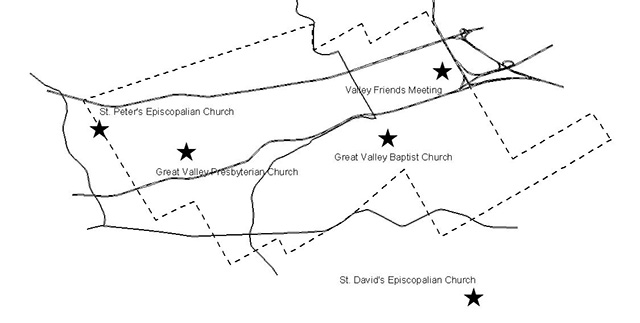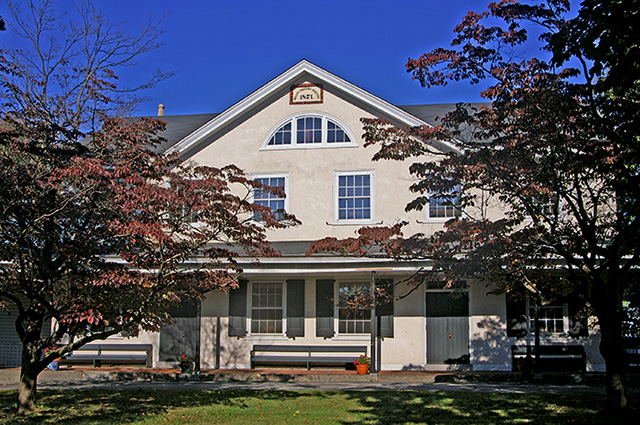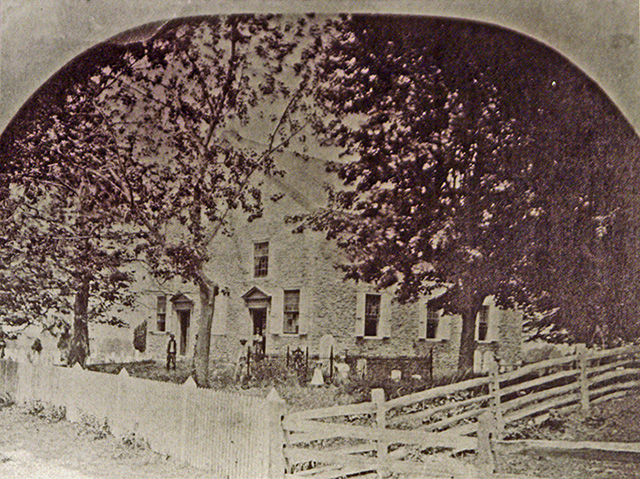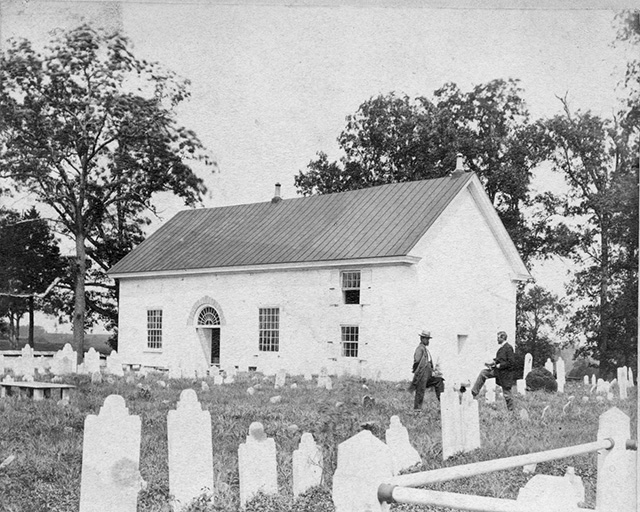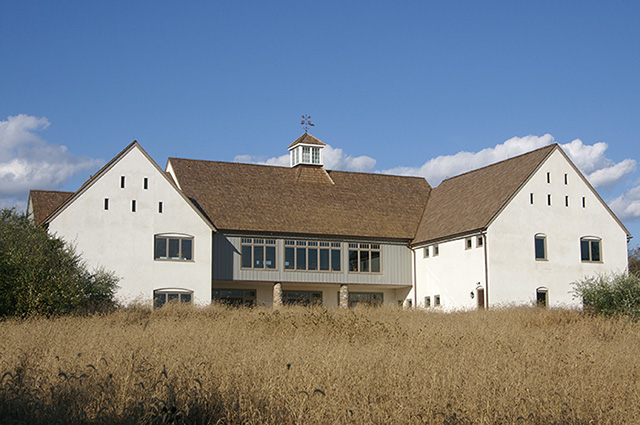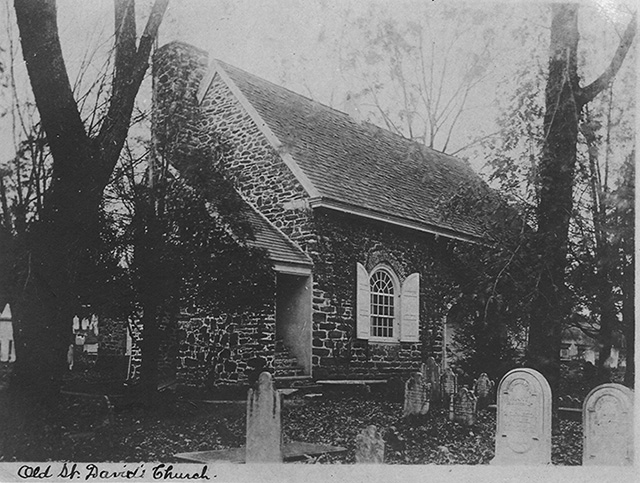|
Home : Quarterly Archives : Volume 44 |
Tredyffrin Easttown Historical Society |
|
Source: Winter/Spring 2007 Volume 44 Numbers 1&2, Pages 12–14 18th Century Churches
Lewis Walker, the first Tredyffrin settler, was a member of Radnor Friends Meeting, having first settled in Radnor. As other Friends moved into the Tredyffrin locality they began to meet at Walker's and Joseph Richardson's houses. This arrangement continued until Lewis Walker's death in 1728. In his will he left land for a meeting house. The first meeting house was completed in 1731 close to Lewis Walker's house on what is now Old Eagle School Road. It was probably made of logs. This building was used as a hospital for sick and wounded soldiers during the time of the Revolutionary War encampment.
Valley Friends Meeting Later George Washington observed that before he arrived at Valley Forge he had looked upon the Friends as sympathizers with the British, but during the winter of 1777/1778 he found them to be extraordinarily kind and completely reliable. The present meeting house, which is across the road from the site of the original Meeting, was opened in 1872. This new Meeting House was divided by a moveable partition to allow men and women, at certain times, to hold their separate business and worship meetings. The original machinery used to raise and lower these partitions remains stored in the attic of the building. It was not until the late 1930s that the Valley Meeting became a monthly meeting in its own right, and independent from the Radnor Meeting. The Baptist Church in the Great Valley In the year 1701 a group of Welsh Baptists moved into the township, and by 1711 they had organized a church. In 1722 the community built a log meeting house. One of its remarkable features was that it had a stove inside it. (In other churches attendees brought their own coals, or heated bricks, in cold weather in order to warm the box pews through the long services.) David Jones joined the church as pastor on the eve of the Revolution (see his biography). During their British encampment in September 1777 troops looted the church.
The Baptist Church in the 1860s (notice the separate doors for women and men) 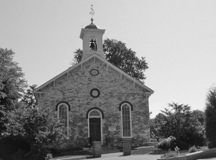
The Baptist Church 2007 The present church building was built in 1809. The church spawned a number of other churches including the French Creek Seventh Day Baptist, Vincent Baptist Church, Lower Merion, Phoenixville, Norristown, Willistown, West Chester, and Radnor Churches. Missions were also sent out to other parts of the country. The church has a history of social activism, including being a leader against slavery in this area. In 1820 women were allowed to vote on church matters. Baptisms were originally performed in Deer Creek next to the church. The church records include a “call to baptism,” at which time the women of the church petitioned the deacons to be sure to go down and clean out all the snakes by the creek – or they were not coming! 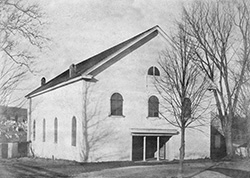
The Presbyterian Church, 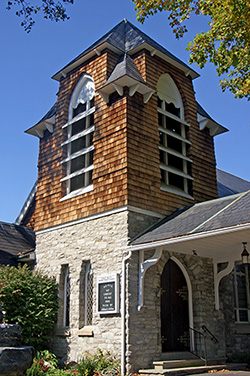
Presbyterian Church 2006 The Great Valley Presbyterian Church Welsh Presbyterians organized the Great Valley church in 1710, the first Presbyterian Church in Chester County. Soon afterwards James Parry willed land for the Church fronting Swedesford Road. In 1720 a log church was erected on the land. A stone building was completed in 1793, and the present building completed in 1890. In 1710 David Evans was taken on as a lay preacher and told to apply himself to learning and study. In 1713 he graduated from Yale College and was ordained in 1714. An acrimonious split occurred in the congregation and his farewell sermon was one of the briefest on record: “Goats I found you, and goats I leave you.” After a couple of years the heat died down and he described the house of worship as “a church of Christians.” The Presbyterian and Episcopal churches have similar early history. Welsh was initially used for services, and in both the pastor had to attend to multiple churches. Episcopal Churches There were two Anglican churches serving the township in the 18th century, St. David's in Radnor, and St. Peter's in the Great Valley. St. David's is sited south of the township, while the St. Peter's site straddles the Tredyffrin – East Whiteland Township boundary. St. Peter's Church was established around 1700; the earliest burial in the churchyard may date back to 1703 (before the township was organized). A log church was built around 1715. William Currie was appointed as a missionary pastor in 1737. He had emigrated from Scotland and was the first pastor not to give services in Welsh. As well as being pastor for St. Peter's his parish included St. David's in Radnor and St. James' in Perkiomen. The log church at St. Peter's was replaced by a stone building in 1744. Pastor Currie resigned his position in 1776, but he continued serving the church until 1785. In 1786 St. Peter's became a part of the newly-formed American Episcopal Church and, in 1788, its first full-time rector was appointed.
St. Peter's Church, about 1870 In the 1830s the church was modernized and stove installed. The church was expanded again in 1856. The 1890s saw a low point in the history of the church, and it closed for four years. A revival took place in 1900 and since then the church has seen continued growth.
St. Peter's Fellowship Hall, completed 2006 Since Radnor was settled before Tredyffrin it would be expected that the church in Radnor came into existence first, but there is little evidence to support that supposition. The Society for the Propagation of the Gospel, which paid for the Anglican missionaries who were ministers in the colonies, was not organized until 1701. The oldest information on services at St. David's suggests they were only first organized in 1700. The stone church was built in 1717.
St. David's, Radnor |
| Previous Article ⇐ ⇒ Next Article |
